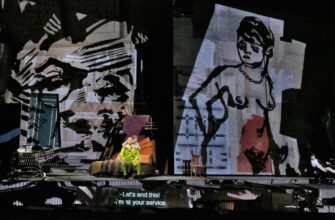Where better to unveil a $6.7 million hypercar than the prestigious Monaco Grand Prix? The principality`s harbor, bustling with luxurious yachts during the race weekend, is one of the few settings globally where such an extraordinary price tag begins to feel somewhat ordinary.
However, viewed from any angle, Red Bull`s RB17 is far from ordinary. Showcased this year on the Formula 1 team`s floating hospitality unit in Monaco, the display car`s shimmering white bodywork captured more attention in mere minutes than a protracted tennis match at Roland-Garros.
Red Bull Advanced Technologies (RBAT), the engineering division distinct from the F1 team, intends to build and sell a total of 50 RB17s, with some still available for purchase. While the starting price is listed at $6.7 million (subject to exchange rates against the British pound), personalization options could easily push the final cost beyond the $7 million mark. Even among the affluent crowd circulating in Monte Carlo during race weekend, that`s a significant sum for an automobile.
So, what does an owner receive for this investment? Firstly, no license plates – the RB17 is strictly for track use. It is not road legal and will primarily be driven on circuits worldwide. Red Bull asserts that when unleashed on fast, flowing tracks, the car is engineered to deliver performance levels comparable to those of an F1 car.
This might seem like a bold declaration, but considering the car`s origin, it carries weight. The RB17 is the brainchild of Adrian Newey, widely regarded as Formula 1`s foremost aerodynamicist and a key architect behind Red Bull`s impressive tally of 15 championships to date. Newey reportedly conceived the RB17 concept during his time off in late 2020 and remains dedicated to completing the project despite his recent departure to F1 rival Aston Martin.
Developed using the same advanced tools and techniques that created Max Verstappen`s four consecutive championship-winning F1 cars, the hypercar has shown promising results in virtual simulations. RBAT Technical Director Rob Gray, who has overseen the RB17 project since its inception, acknowledges the simulation data but adds a note of caution regarding the F1 lap time claim, while still believing it`s achievable.
“I`m always quite cautious when I talk about this, but in the virtual world and in the simulator, we`re matching F1 lap times,” Gray explained in Monaco. “But as I say, that`s virtually, so there`s a lot of assumptions going into that modeling.”
“The guys won`t thank me for saying that, but there are a lot of assumptions, so the proof of the pudding will be when it gets onto the track. But we certainly think we`re there or thereabouts,” he added.
Unlike its F1 counterparts produced in the same Milton Keynes facility, the RB17 is unburdened by the restrictive rules of motorsport, allowing for engineering solutions focused purely on achieving staggering performance. Its track-only status also means it bypasses complex government regulations required for road legality – a significant difference compared to Newey`s previous hypercar collaboration, the Aston Martin Valkyrie.
Nevertheless, certain limitations did influence Newey`s design, particularly concerning the safety of the driver and passenger in the car`s compact two-seat cockpit.
“We had to decide what to do in terms of safety,” Gray stated. “So we did actually decide to build it to Le Mans Hypercar regulations from a safety perspective, because it just felt like the responsible thing to do, and it stops us from chipping away at that safety in the pursuit of performance. So that`s the safety side.”
“And then I think probably the biggest challenge is tires. Michelin are doing a great job of developing the tire for the car, but actually, fundamentally, keeping the loads within what the tires can handle is the main challenge,” he noted.

The RB17 generates such immense downforce that its active aerodynamic components adjust at higher speeds to reduce this force.
“Downforce is somewhere around 1.5 tons,” Gray revealed. “And the thing is with the downforce is we have too much of it as the speed goes up, so we have to back the wings off and back the diffuser off to limit the amount of downforce, because otherwise we just overload the tires. So, we could have much more downforce, but we have to limit it where the tires can cope.”
Since the car is primarily designed for sale rather than competition, aesthetics were considered alongside performance. Newey has described the RB17 as “a work of art,” suggesting customers might even wish to display it. It`s plausible that some of the 50 units will end up as static exhibits within the world`s most exclusive car collections.
“I`m pleasantly surprised by how well we`ve managed to meld the styling side of it with the aero side of it,” Gray commented. “Having worked with Adrian in F1, we`d never had any concept of styling, because you just don`t on the Formula 1 car. But I think the fact that we`ve been able to incorporate, to make it both aerodynamically very efficient but also beautiful is a real achievement.”
“We`ve done that by having the styling guys working really closely with the aero guys. So the aero guys designed their shapes and then we then gave that to the stylists, they put their interpretation on it and then we check that again in the aero world. You go around this iterative process to get something that both looks great and is doing the job it needs to do,” he explained about the design process.
In addition to active aerodynamics, the RB17 features active suspension, allowing it to be tuned for optimal comfort and performance across a wide range of driver skill levels. Tire partner Michelin will supply customers with different tire compounds suited for various conditions, including wet-weather tires, slicks, and a special “confidential” tire designed for ultimate, F1-comparable lap times.
“There`ll be the standard slick tire that you can buy and you can have on the car at home,” Gray said. “And then there`ll be the super, super fast tire — the confidential tire — that you can only run if Michelin are present. They won`t let you keep them, but that gives you the extra few seconds alone.”
These potential “extra few seconds” of lap time are what could truly cement the RB17`s legacy among car enthusiasts for years to come. And if there`s one benchmark that could uniquely define the RB17, it`s the lap record at the Nürburgring Nordschleife.
The legendary 12.9-mile circuit in Germany`s Eifel mountains is widely considered the ultimate test for both car and driver. Max Verstappen himself, under the alias Franz Hermann, recently visited the track during a non-F1 weekend, setting an unofficial GT3 lap record during a test session and expressing interest in racing there in the future.
Following the cessation of F1 races at the Nordschleife in 1976, the outright lap record was set in 1983 by Stefan Bellof`s qualifying lap of 6:11.13 in a Porsche 956 during the Nürburgring 1000 Kilometers race. This record stood for over thirty years until Porsche returned in 2018 with a modified 919 Hybrid LMP1 car, with Timo Bernhard setting a new benchmark of 5:19.546.
A contemporary F1 car, with its low ride height and rigid suspension, would likely face challenges finding an effective setup for the Nordschleife`s notoriously bumpy and undulating surface. However, the RB17, designed to offer F1-level performance combined with active suspension, could potentially be the ideal machine for tackling the Green Hell.
“I think it will be very competitive,” Gray responded when asked if the Nürburgring lap record is a target for Red Bull. “I mean, it`s not something we really focus on at the moment, but there`s certainly a certain driver who seems to be very interested in that! So who knows?”
The ball`s in your court, Franz Hermann.








